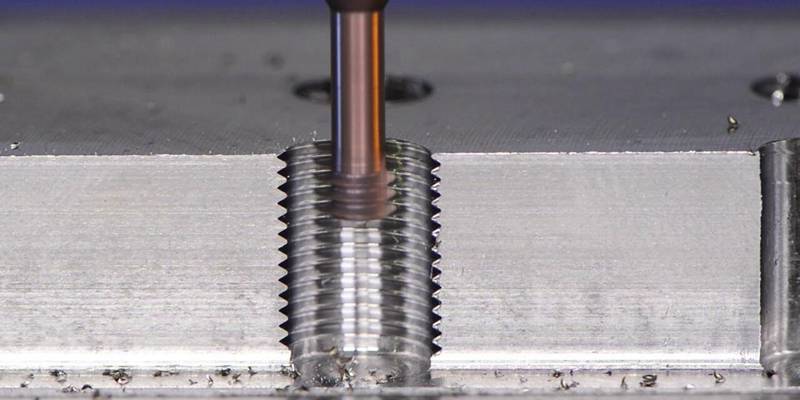- February 10, 2023
As long as screws are still present in machined parts, threads remain an important aspect of metalwork. It facilitates the connection of parts at a low cost, making them ideal for use with fasteners, fittings, and connectors.
Asides from knowing what threads are, it is also important to identify the right type of thread for your project. So, what exactly does the term machining threads mean? what are the types of machining threads? Keep reading as we answer these questions and provide other important information about threading.
What is Thread Machining in Part Manufacturing?
Thread machining is one of the most important applications in a CNC machining center. It is a subtractive method used in making external and internal threads of different sizes. This machining occurs through the circular movement of a rotating tool calibrated with the required thread depth and density.
The primary function of a thread is to act as a coupling agent between two mechanisms. During the coupling process, motion between parts occurs.
A thread has different parts. These include the crest, root, Helix angle, pitch, and flank. Let us examine these parts in detail.
Main Parameters for Thread
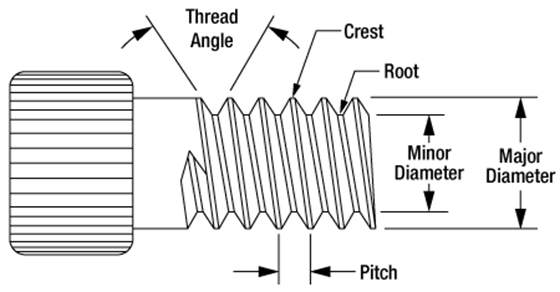
Helix Angle: Helix angle in machining is the angle between the thread axis and the helix in a straight thread or the angle made by the conical helical area of a thread for taper threads.
Root: This is the bottom of the threads. It is the adjacent area of the projected cone or cylinder.
Crest: The crest is the top of the threads. It is the farthest area of the projected cone or cylinder. The crest is also the thread surface that joins the flanks.
Flank: This threaded part connects the root to the crest. In theory, the intersection of a flank surface with an axial plane is a parallel line.
Pitch: The diameter of the pitch equals that of the cylinder or cone, in theory. The pitch is the distance measured between areas on adjacent threads. The parallel areas measured must correspond.
Types of Machining Threads
There are many types of threads according to different classification standards. For the Unified thread system, the UNF (fine) thread and UNC (coarse) thread are standard. However, the two major types of threads are internal and external threads.
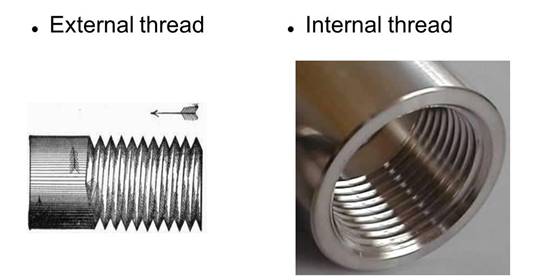
Internal Threads
An internal thread, also known as a female thread, undergoes machining using a single-lip threading tool. Aside from this single-lip tool, a traditional threading cap could also help cut CNC internal threading. It is important to note that cutting internal threads occur only on concave surfaces.
So, when is an internal thread needed? You would require one if your workpiece needed screw insertions. Machinists use either hand taps or machine taps for cutting internal threads.
External Threads
Also known as a screw thread, this type of thread finds application in screws, bolts, studs, and plug gages. Using a lathe is one of the most effective ways of making external threads.
Another method is to use a round die to cut the external thread by hand. The round die used in this case remains in a fixed die stock. Aside from round dies, there are also hexagonal square dies, ideal for interlocking use.
How to Cut a Machining Thread?
Thread cutting is ideal for making parts with screwed connections. Knowing how to cut threads is beneficial. For instance, with this knowledge, you can manufacture a single-piece screw or nut or repair them if necessary. Also, threading machines may not always be available.
So, here is how to cut threads.
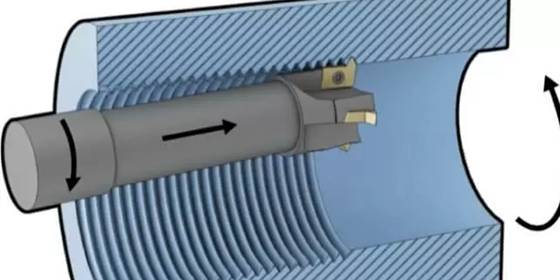
1. How to Cut an Internal Thread
Are you looking to cut an internal thread? First, get the right tools, which include safety goggles, a box column drill (for machine taps), an adjustable tap wrench (for hand taps), an internal tap, a twist drill, and a 90-degree countersink.
After getting the right tools, the next step is determining what diameter of the hole you want to place the thread in. With the diameter determined, knowing the right tap for cutting is the next stage. To determine the core hole diameter, subtract the thread pitch from the Tap diameter.
To start cutting the internal thread, you first center with a punch and then drill a core hole using a twist drill. To make a chamfer into the core hole, use the 90-degree countersink. Cutting the thread involves turning the tap wrench into the core hole with the tap attached.
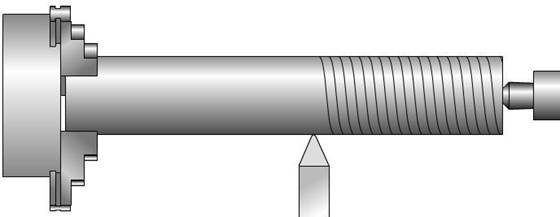
2. How to Cut an External Thread
Tools you need to cut external threads include file, die stock, flat-tip, round die, rod, vise (for gripping), and cutting spray.
To cut external threads, file the edges of the round rod first and then chamfer it at an angle of 45 degrees. Ensure that when compared to the depth of the thread, the chamfer is bigger.
The next step is clamping or gripping the round die to affix it firmly. This prevents unwanted motion since the rod requires a lot of pressure to cut the external thread optimally. Use cutting sprays to improve the quality of the part’s surface.
Great Tips for Machining Thread
There are several benefits attached to knowing how to machine threads. However, getting great tips for machining might spell the difference between an optimal thread and a suboptimal one. So, here are some tips for machining threads.
- Include a chamfer to external thread end parts;
- Ensure the starting end of a thread has a flat surface. Also, ensure that it is consistent with the central axis of the thread;
- Make internal threads end with a countersink;
- During forming or cutting thread, tubular parts often experience pressure, which is why they should have increased wall thickness;
- While going for unique thread sizes is fine and good, using a standard thread size is more economical;
- Lower-height threads are preferred to higher-height ones if there are no thread specifications.
Common Screw Thread Machining Methods in CNC Process
There are several screw thread machining methods in CNC. These different methods have their features and benefits. Here, we’d discuss the common ones and what makes them stand out.
1. Tapping
Tapping holes are ideal for use in producing internal threads. It is an economical as well as efficient threading method. This CNC method is applicable for use in threaded holes with the low accuracy of position as well as holes with a small diameter.
It as a method of screw thread machining has reduced CNC threading machine downtime. Also, the machining structure here is quite simple compared to other methods. Furthermore, tapping is a high-speed cutting process that greatly improves productivity and machining efficiency.
Cutting tools used in this machining method are cheaper, thereby reducing the cost of manufacturing. It is also a versatile process with a wide range of applications.
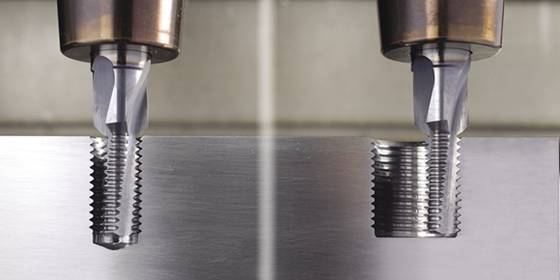
2. Thread Milling
This is another method used in making screw threads. This process utilizes a milling cutter as well as a 3-axis machining center. It also adopts a circular interpolation of the three main axes; x, y, and z linear feed. Thread milling is ideal for threading large parts or materials of high value.
Thread milling has a fast processing speed, high precision, and efficiency. The milling tool used often contains hard alloys. Also, milling cutter tools are versatile, reducing the need to acquire different tools for different milling processes. For instance, the same cutter can cut the left and right-hand thread using the same pitch of screws. You can adjust the hole diameters, tolerances, and material cut with minimal difficulty.
Threads made using milling have a superior-quality surface with zero burrs. This method is ideal for making thin-walled parts, machining blind holes, and asymmetric/ non-rotating parts.
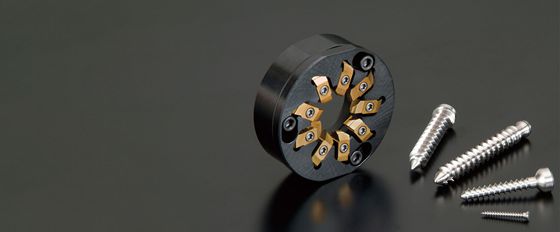
3. CNC Threading on Lathes
Thread cutting on a lathe is another common screw threading process with a wide range of adoption. CNC lathes facilitate the production of high-quality screw threads. With this method, machinists can make several tapered threads, lead threads, and thread pitches.
Rigid tapping and single-point threading are two of the most common methods used in CNC lathe threading. Single-point threading uses a tool with an indexable insert with a shape and size that corresponds to that of the finished screw head.
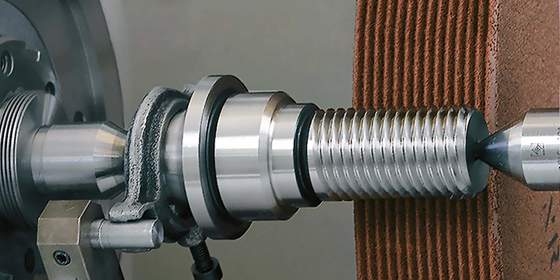
4. Thread Grinding
This is ideal for use in threading hardened workpieces. Two main types of grinding wheels are used for this process; multi-line grinding wheels and single-line grinding wheels. The single-line grinding wheel has a pitch accuracy with grades 5 ~ 6. It also has a surface roughness of R1.25~0.08 μm.
Single-line grinding is ideal for making a precision screw, worm, thread gauge, shovel grinding hob, and small batch threading.
The multi-line grinding is divided into cut-in and longitudinal grinding methods. The major difference between these two methods is the width of the grinding wheel. In the longitudinal method, the width of the grinding wheel is less than the length of the thread being ground. On the other hand, the width of the grinding wheel used in the cut-in method has a greater length than the thread.
Get Thread Machining Services at WayKen
Machining threads is a challenge because of the need for skilled and professional equipment. If you want to make standard threads that stand the test of time, then WayKen is the right company for you.
Who is WayKen? We are a machining company with over 20 years of experience making parts that meet industry standards. With us, your threading project is in good hands as we have one-stop CNC machining services and advanced machines to attend to your order.
Conclusion
To produce high-quality parts, it is important to have an in-depth understanding of the various manufacturing processes involved. Knowledge also enlightens you on how to deal with some machining challenges like chatter in machining.
Machining threads are an important aspect of most products that require coupling or connection. Knowing how they work, their parameters and the different machining processes available would help you make the right machining decisions.
FAQ
Is thread milling faster than tapping?
Tapping is generally quicker than thread milling. However, thread milling machines sometimes feature additional edges to compensate for the reduced speed.
What is the difference between a thread mill and a tap?
The major difference between thread milling and tapping is the smoothness of the cut. Thread milling creates smoother and more even cuts, while cuts made by tapping are rough and jagged.
What is the threading operation in the lathe?
It is a process used to create a helical ridge with a uniform cross-section on the workpiece. It involves using a threading tool bit to make cuts on the workpiece successively. It is important to note that the tool bit used for this operation should be the same shape as the thread needed.

